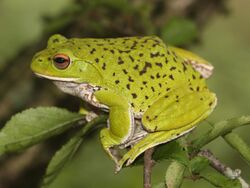Biology:Zhangixalus arboreus
| Zhangixalus arboreus | |
|---|---|

| |
| Scientific classification | |
| Domain: | Eukaryota |
| Kingdom: | Animalia |
| Phylum: | Chordata |
| Class: | Amphibia |
| Order: | Anura |
| Family: | Rhacophoridae |
| Genus: | Zhangixalus |
| Species: | Z. arboreus
|
| Binomial name | |
| Zhangixalus arboreus (Okada & Kawano, 1924)
| |
| Synonyms | |
| |
Zhangixalus arboreus, also known as the forest green tree frog and Kinugasa flying frog, is a species of frog in the family Rhacophoridae endemic to Japan, where it has been observed on Honshu island, as high as 2000 meters above sea level.[2][3]
Appearance
The adult male frog measures about 42-60 mm in snout-vent length and the adult female frog about 59-82 mm. They have more webbed skin on their front feet than on their hind feet. The skin of the dorsum is bright green, sometimes with spots. The skin of the belly is white with brown spots. The iris of the eye is red-brown in color.[3]
Habitat and life cycle
The natural habitats of Z. arboreus are subtropical or tropical moist lowland forest, freshwater marshes, and irrigated land. These small tree frogs spend their adult lives in trees and forests, and in breeding season gather around water sources to mate. They lay their eggs within a batch of sponge-like foam which is suspended from a tree branch, usually hanging over a pond, marsh, or slow-flowing stream. The tadpoles emerge from the eggs, wiggle their way out of the foam, and drop down into the water below. These batches of foam can often be seen hanging over ponds in the Japanese countryside in late spring. Sometimes the frogs mistakenly lay their eggs over inappropriate bodies of water, such as swimming pools, wells, or even buckets containing rainwater.
Relationship to humans
This species of tree frog is a rarely seen in the exotic pet trade, with the majority of these individuals being of wild-caught origin. Despite this, there has been an increase in the captive breeding of Zhangixalus arboreus for the pet trade in both Japan and South Korea . In 2023, Zhangixalus arboreus was captive bred for the first time in the United Kingdom by Gary Miller, head of Zoo at Sparsholt College.
Human tourists also visit Z. arboreus breeding pools to observe the animal in its natural habitat.[3]
References
- ↑ IUCN SSC Amphibian Specialist Group (2021). "Zhangixalus arboreus". IUCN Red List of Threatened Species 2021: e.T58973A177226592. doi:10.2305/IUCN.UK.2021-1.RLTS.T58973A177226592.en. https://www.iucnredlist.org/species/58973/177226592. Retrieved 17 November 2021.
- ↑ Frost, Darrel R.. "Zhangixalus arboreus (Okada and Kawano, 1924)". American Museum of Natural History, New York. https://amphibiansoftheworld.amnh.org/Amphibia/Anura/Rhacophoridae/Rhacophorinae/Zhangixalus/Zhangixalus-arboreus.
- ↑ 3.0 3.1 3.2 Kellie Whittaker; Michelle S. Koo, eds (October 13, 2005). "Zhangixalus arboreus (Okada & Kawano, 1924)". University of California, Berkeley. https://amphibiaweb.org/species/4496.
External links
Wikidata ☰ Q2701830 entry
 |


